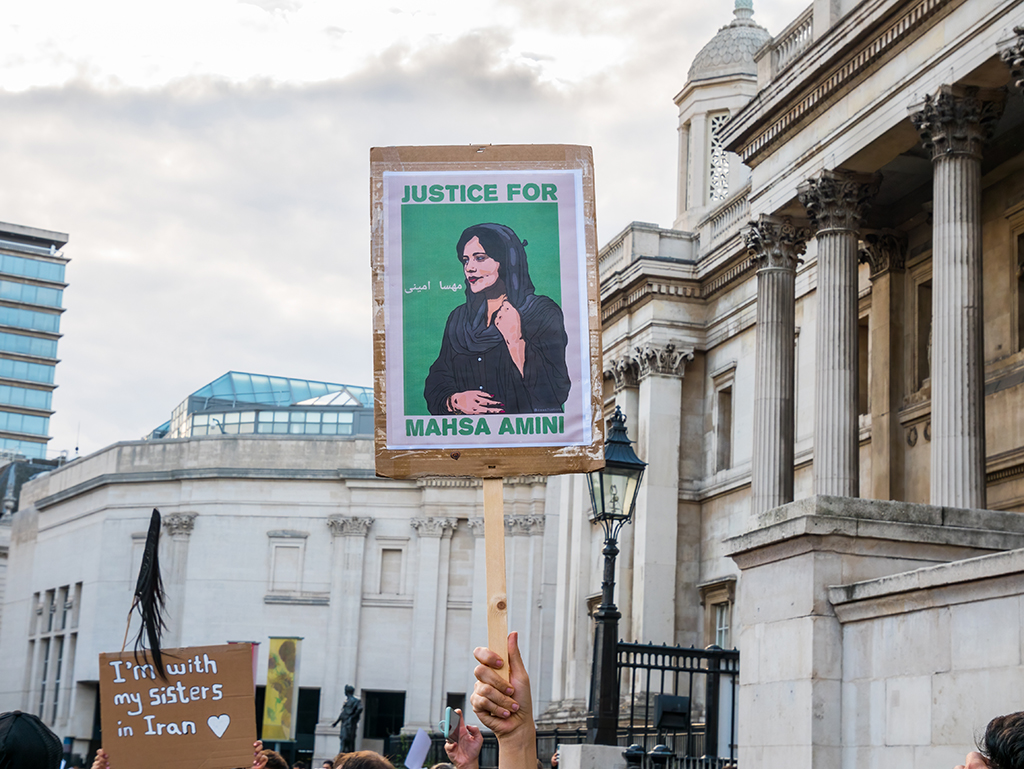“Women, life, liberty.” These words are ringing out on the streets of every city in Iran, as women come out to tell the repressive enforcers of the Islamic Republic that they have had enough.
The death of 22-year-old Kurdish Iranian woman Mahsa Zhina Amini, on Sept. 16, at the hands of the republic’s “morality police,” has sparked huge protests across the country. The regime’s brutal response has so far resulted in the deaths of more than 400 protesters and the arrest of more than 20,000.
Amini was murdered by the morality police for not wearing her hijab properly, according to the rigidly enforced Islamic Penal Code. To demonstrate their fury at her death and their continuing oppression, Iranian women have been taking their headscarves off and burning them. Unable to drown the loud and determined voices of the Iranian people, the Islamic Republic has turned once again to its usual tactics: violence, internet shutdowns, mass arrests and killings.
Standing shoulder-to-shoulder, Iranian women chant for their freedom. These images appear unprecedented. But for anyone who has followed Iranian politics and society over the years, what we are seeing on the streets of Iran’s cities is no surprise. They are the reaction to more than four decades of brutality and violence and the climax of years and years of resistance.
The slogan “Women, life, liberty,” adopted from Kurdish, honours Amini’s heritage and connects the Iranian women’s movement to one that is collective and transnational. Even schoolgirls have taken part. Taking off their uniforms, exposing their hair, they give the finger to the Islamic Republic. They are singing for their freedom. Twenty days into the protests, we are witnessing a truly feminist revolution in the making.
This picture of schoolgirls in Iran.
— Mona Eltahawy (@monaeltahawy) October 3, 2022
Wow.
via @theasianfmnst via @1500tasvir #MahsaAmini #IranProtests2022 #IranRevolution pic.twitter.com/JlFjmMjuec
And yet, global feminist solidarity has traditionally been disappointing when it comes to the struggle of Iranian women against this patriarchal dictatorship. For example, many female western state officials who have visited the Islamic Republic have complied with its dress code for women. This has the undesired effect of normalizing the policing of women’s bodies.
The images emerging from the streets of Iran’s cities — of loud, defiant, courageous women going face-to-face with their oppressors — don’t fit a common western narrative of Iranian women being ultra-modest and submissive. More generally, this contrasts with common media and Hollywood depictions of Middle Eastern women that offer racial and gender stereotypes instead of complex or diverse representation.
The compulsory hijab for the Islamic Republic is a symbol of subjugation over women, a tool for oppression. The inequality Iranian women experience goes beyond the way they dress. From child custody, divorce laws, to bodily autonomy, and even the right to leave the country, their every action is controlled by a ruthless regime.
But it is more than just that. From the Islamic Republic’s inception in 1979, visuals have played a crucial role in cementing this regime and its propaganda. Forcing the hijab onto every single young girl and woman was a way for the Islamic Republic to carry out its ideology using women’s bodies, a way for it to create a visualization of a supposed homogeneous Islamic state.
These visual signifiers are central to how the regime operates and holds onto power. More importantly, it’s the way the regime maintains its image and brand, within Iran, in the region, as well as to the outside world.
This means that not only is the compulsory hijab a tool for oppression, but it is an emblem to represent the Islamic Republic. To burn it is to reject the regime in its entirety. The women of Iran are using the very symbols of the regime to reject its legitimacy as they call for change.
History of resistance
Expressions of dissent and acts of disobedience have taken many forms over the 43 years of the Islamic Republic. Women have had to negotiate with the state’s red lines to challenge systems of power for years.
They have tried to express their agency and dissent through various acts such as wearing bright lipstick or colourful clothing, exposing hair under their compulsory hijab, or daring to dance — all in an effort to retain some bodily autonomy.
But protests against the compulsory hijab have roots going back to the beginning of the Islamic Revolution in 1979. And while in recent years Iranian women have become more vocal both on social media and the streets of Iran, their acts of resistance have been met with violence and imprisonment.
Today, Iranian women are telling the Islamic Republic as well as the men around them and the outside world that they will no longer negotiate. “Women, life, liberty”: these are the words that fill the streets of every city across Iran. A clear, collective and loud stance against the Islamic Republic and everything it stands for. ![]()
![]()
Read more: Rights + Justice, Gender + Sexuality, Media















Tyee Commenting Guidelines
Comments that violate guidelines risk being deleted, and violations may result in a temporary or permanent user ban. Maintain the spirit of good conversation to stay in the discussion.
*Please note The Tyee is not a forum for spreading misinformation about COVID-19, denying its existence or minimizing its risk to public health.
Do:
Do not: